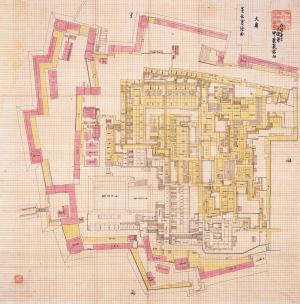Illustration of the Inner Palace in the Kanei period (Kaneido Ezu Ōoku)
Important cultural property "Materials on the construction of Edo Castle" Duplicate of the original by Kōra Buzen Tokyo Shiryō Collection 6181-6
This is a drawing of the inner palace of the innder citadel. In this work there was a tag attached which read, "Drawing of inner palace during the Kan'ei period," but according to existing studies, it is considered to be actually depicting the inner palace of Edo Castle during the Manji period when the castle was reconstructed having been burnt down in the Great Fire of Meireki.
There seems to have been such a place as the inner palace, the lord of the castle and his family led theirr private lives, in Edo Castle since the era of Tokugawa Ieyasu. However, from the time of the second Shogun Hidetada 1618 (Genna 4), a law called the "Inner Palace Mandate" came into effect, and from then on there was a separation between the "Front" where the Shogun administered political affairs, the "middle-inner palace" where the shogun lived, and "the inner palace" where the Shogun's children and wife lived.
According to this drawing, it is understood that the inner palace at that time was formed into three areas with the "Goten-muke" which served as a chamber when the Shogun slept in the inner palace, his wife's living room, and the waiting area for maidservants, the "Nagatsubone-muke" where maidservants lived and the "Hiroshiki-muke" where Hiroshiki officials waited. The Hiroshiki officials were male servants who worked in the inner palace and were in charge of clerical administration as well as security and inspection.


